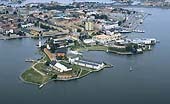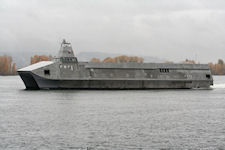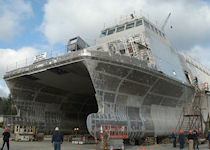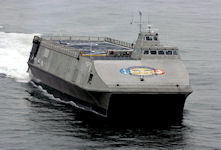I really hope that this similar environment could happen in Malaysia. We want our politician have a sound knowledge of security, naval operation, military requirement, its important and its latest technology. And they can fight together with the user, Royal Malaysia Navy to get an appropriate budget from the treasury. Too much to ask? We are lucky if they can spell LCS in full sentence.

The ship that was to revolutionize surface warfare has been controversial since its inception 12 years ago. But the firestorm over the littoral combat ship might have been avoided had the Navy better explained the rationale for the ship and answered critics' questions more clearly, said Chief of Naval Operations Adm. Jonathan W. Greenert.
"There are still questions" about the future of LCS, Greenert told reporters May 21. Among them is how the Navy will address testers' concerns that the ship is too lightly armed and susceptible to enemy attacks. Former Deputy Defense Secretary Christine Fox called LCS a "niche platform" that can only operate in "permissive" environments.
Greenert said those are valid questions that Navy leaders have not answered as comprehensively as they should have. "We probably should have been more clear. Now we will be," he said.
Growing doubts about LCS led Defense Secretary Chuck Hagel to truncate the program from the Navy's original goal of 52 ships down to 32. Hagel has asked the Navy to rethink how it might build a future small surface combatant and to evaluate more “capable and lethal” alternatives to the LCS.
Greenert insisted that it was the Navy's plan all along to upgrade the ship over time and improve its survivability, but that the concept was not communicated properly.
"I don't think we made any mistakes per se, but I think we could have been more clear on our intention for taking the sea frame and evolving it through the life of the ship," he said. Greenert noted that some of the Navy's most successful ship classes grew in fits and starts, not unlike LCS. The Oliver Hazard Perry class frigate had four flights, he said, using the Navy term for technology updates. The Spruance-class destroyers went through two flights and the Arleigh Burke-class destroyers had four.
"We never really articulated formally or discussed the feasibility of having flights" in the LCS program, nor has the Navy explained "how we intended to upgrade it for survivability," said Greenert.
That issue was at the center of Hagel's decision to stall the program. He has asked the Navy to explain how the LCS will evolve, said Greenert.
There are currently two LCS variants — the Freedom-class monohull built by Lockheed Martin and the Independence-class trimaran made by Austal. Both were built to be outfitted with "mission modules" of weapons, unmanned underwater vehicles and other equipment for surface warfare, mine countermeasures or anti-submarine warfare.
"This is a very transformational concept," said Greenert. "As with any first of class ship and aircraft, complications emerge."
Why the ship ended up being the subject of relentless criticism is not anyone's fault in particular, said Greenert, who declined to point fingers. "I don't want to be judgmental."
Within the Navy, leaders had become complacent and comfortable that the program was on track, he suggested. With Hagel's review, the service has a fresh opportunity to make its case for a future small surface combatant and ensure it is funded in the 2016 budget, Greenert said.
One of the reasons why the Navy did poorly at selling LCS within the Defense Department and to Congress, he said, was turnover and difficulties managing changes that were made over the years to ship designs and to procurement strategies. "People change offices. It was very difficult to keep up, I think." Now, he added, "We've reached a node where people are saying we need to take a deep breath and take another look at this."
Greenert and Navy Secretary Ray Mabus in March created a small surface combatant task force to study LCS alternatives. Led by John Burrow, executive director of the Marine Corps Systems Command, the group isevaluating industry proposals and by July 31 will recommend which ideas merit further consideration.
“If we go to a new design, it has to be mature,” Greenert said. “If something is compelling, but would take more time, we'll relay that to the secretary.”
Cost also will be major concern. The rising price of LCS — from initial estimates of $220 million per ship to more than $700 million — nearly sank the program in its earlier days. If a new ship is deemed unaffordable, the Navy might consider upgrading existing LCS vessels with offensive and defensive weapons and sensors.
Congress, meanwhile, is becoming increasingly skeptical. The House Armed Services Committee approved cuts that would leave the program with insufficient funds to procure three LCS in fiscal year 2015. “Deferring additional ships into fiscal year 2016 would compound the already significant challenges the Navy faces in funding the shipbuilding account in a fiscally constrained environment while increasing overall costs to the Navy and increasing risk to the industrial base, including sub-tier suppliers,” the Obama administration said in a statement.
Photo Credit: Navy
Article from: National Defence
5/21/2014
By Sandra I. Erwin
The Critic:
The problem with the US Navy LCS-class is...WHAT does it DO?
* It has no sonar, and thus has no torpedo tubes---it has no ASW outside of the HH-60R helicopter
* It has no anti-ship missiles or heavy missiles
* It has limited anti-air missiles (SeaRAM isn't really SAM, it's CIWS Anti-missile missile)
* It has no mine-sweeping equipment
* It's 57mm gun is proven not to be able to hole a steel-sided warship as a Canadian wargame exercise proved (and caught on film)
* The press says its 30mm autocannons in the ASuW mission package has been proven to be unstable when the ship moves at speed...it cannot lock and fire at 40kts.
* It has no ASW or AA module suites whatsoever
* It has no spy sensors or ECM suite
* It has no missiles that can reach beyond 5KM (those on the HH-60R don't count).
So, sure, there's harsh criticism at the LCS because so far it's been shown to sail with the USN flag and be helpful in chasing down Go-Fast drug boats in the Gulf. Other than that, it assumes the role of the USCG NSC and is thus armed as such. It's a ship, yes, new hull, but basically WHAT does it DO? Shrug, it's a light fast gunboat, basically. Sure, it's better armed than an Avenger-class minesweeper, but no one has called the LCS a minesweeper yet.
Look up the capability of a Perry class frigate. It had an air defense missile system, a capability to fire Harpoon missiles, a larger gun, torpedo tubes as well as a helicopter capability. It had a significant ASW sensor suite. The LCS has none of these except the helicopter. So to argue that the LCS was intended to replace the Perry class frigate, given the list of deficiencies that Peter noted, is to say that the Navy has traded something for virtually nothing. As far as mine sweeping, the current LCS does not have a capability - it, like the other modules is only forthcoming. There are 13 mine countermeasures ships listed in the fleet. They can actually sweep mines. To argue that we needed 52 LCSs for mine countermeasures seems to be a misplaced sense of priorities.
As for Greenert's argument that classes of surface combatants have evolved and added capabilities over that evolution is true. However, the critical difference is that a Flight 0 Arleigh Burke destroyer, while not having a flight deck, had a capable air defense system, long range anti-ship missile system, CIWS, a ASW sensor suite and a Tomahawk launching capability. It was a flexible, lethal vessel that only added more capability as it evolved. In contrast, the LCS can do almost nothing except chase drug runners, pirates and purportedly defend against swarms of small high speed lightly armed attackers - clearing out Iranian Guard speedboats in the Straits of Hormuz has been mentioned as a unique capability. If that is all that the LCS can do as currently configured, then we have spent a great deal of money to buy a very limited mission set.







 With Japan’s decision to bolster its defence forces, many Western defence and private maritime security companies (PMSCs) are seeing revived fortunes in the Far East and its nascent market for anti-piracy solutions. In August, Northrop Grumman and Lockheed Martin held a joint press conference in Tokyo to champion the RQ-4 Global Hawk and E-2D Advanced Hawkeye surveillance planes as potential additions to the Japanese Air Self Defence Force.
With Japan’s decision to bolster its defence forces, many Western defence and private maritime security companies (PMSCs) are seeing revived fortunes in the Far East and its nascent market for anti-piracy solutions. In August, Northrop Grumman and Lockheed Martin held a joint press conference in Tokyo to champion the RQ-4 Global Hawk and E-2D Advanced Hawkeye surveillance planes as potential additions to the Japanese Air Self Defence Force.